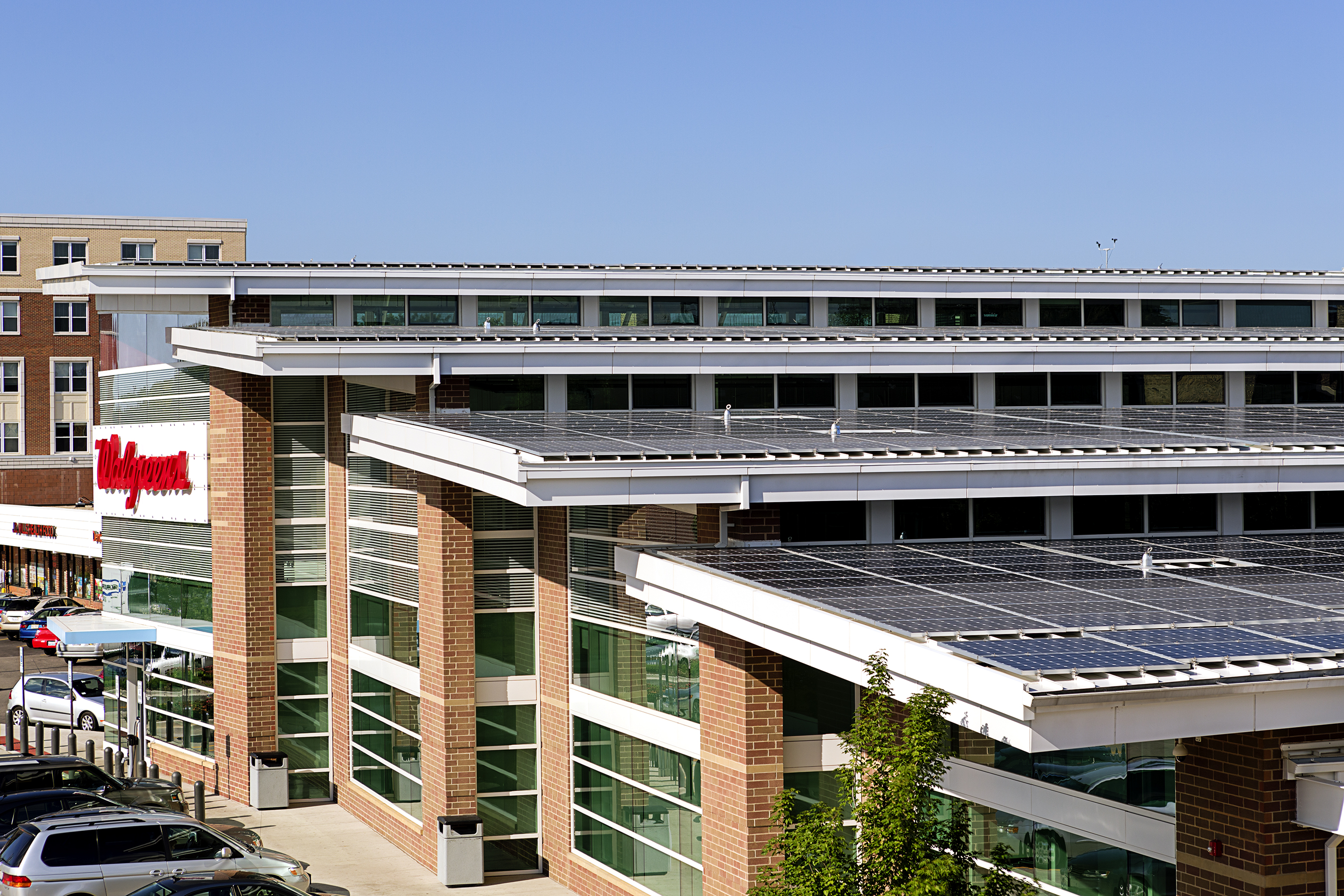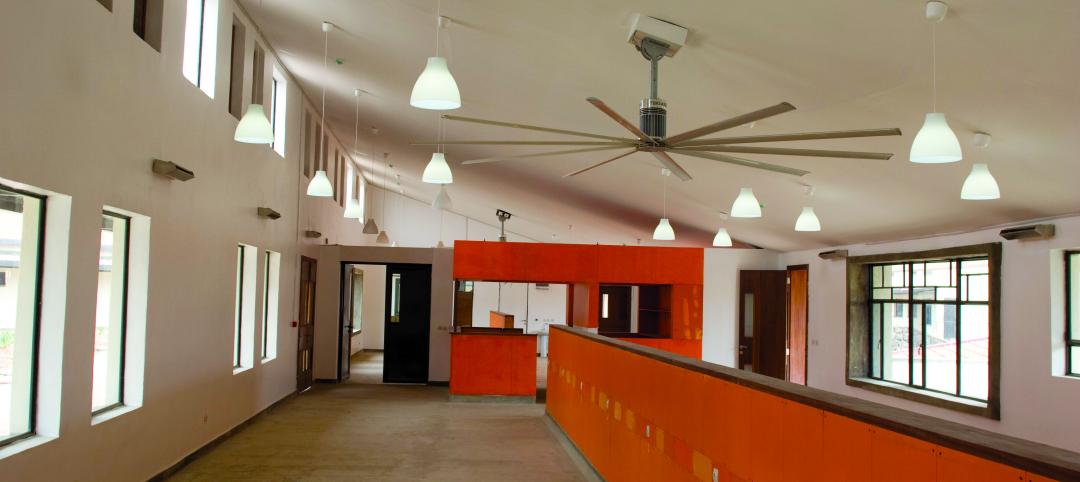Design of the nation’s first zero net energy retail store elevates the typical Walgreens shopping experience from one of convenience to relevance. The new store in Evanston, Ill., features metal and composite material from Petersen Aluminum Corp., and a roof made of tiered sections that support almost 850 solar panels. The clever building design includes enough sustainable features to attempt to earn LEED Platinum status.
The store’s architecture is open and inviting, according to the design by John Bradshaw, licensed architect/planner at Camburas and Theodore Architects in Des Plaines, Ill., and those on his team. The design required roughly 33,000 sq. ft. of Petersen bone white steel coil, plus 7,600 sq. ft. of Reynobond composite panels for the soffits, edge trim and the backdrop that frames the lighted Walgreens signs above the main entrance. Sheet Metal Supply in Mundelein, Ill., roll-formed custom 13-in.-wide roof panels to accommodate the solar panel mounting system. Petersen’s ability to stock coil in non-standard widths reduced scrap and saved money.
The best feature of the building, in Bradshaw’s opinion, is the amount of daylighting. “The clerestory windows at each segment of the roof that we used for daylight harvesting, with the cantilevered roof segments that shade summer sun and provide maximum roof area for the solar panels, the segmented walls that break apart to allow even more daylight harvesting – all these elements acting together created the best look on the building,” he insisted.
The vision for the building incorporated the elements of green design such as daylight harvesting, solar panel arrays and a mechanical mezzanine. “It was our mission to incorporate these items in a meaningful design but, more importantly, to celebrate this new icon of sustainability and to promote its virtues with a design that lifted the typical Walgreens to a new height, both literally and figuratively,” Bradshaw said.
 850 roof-top solar panels attached to metal roof.
850 roof-top solar panels attached to metal roof.
Bradshaw prefers working with Petersen Aluminum products. “Truly, Petersen Aluminum is one of the most trusted products that we specify. We have never had a performance issue with the products, the color selections are broad and they are local, which suits almost all of our needs,” he said.
Inconveniently positioned power lines over an urban lot with restrictions on all sides contributed to a challenging work site, said Chuck Heintzelman of installing contractor WBR Roofing in Wauconda, Ill. “We simply worked around our surroundings like we always do, and made it work,” he said. Regarding Petersen products, Heintzelman added, “We enjoy using PAC-Clad products. Plus, it’s great to be part of a LEED building.”
In addition to the nearly 850 roof-top solar panels that generate enough energy to power 30 Illinois homes for a year, the Walgreens store also includes:
- Two 35-ft.-tall wind turbines, using Lake Michigan breezes to generate enough power to offset annual greenhouse gas emissions from 2.2 passenger vehicles;
- Geothermal energy obtained by drilling 550 feet into the ground below the store, where temperatures are more constant and can be tapped to heat or cool the store in winter and summer;
- LED lighting and daylight harvesting;
- Carbon dioxide refrigerant for heating, cooling and refrigeration equipment;
- Energy efficient building materials.
Engineering estimates – which can vary due to factors such as weather, store operations and systems performance – indicate that the store will use 200,000 kilowatt hours per year of electricity while generating 220,000 kilowatt hours per year.
Thomas Connolly, Walgreens vice president of facilities development, said, “We are investing in a net-zero energy store so we can bring what we learn to our other stores and share what we learn with other companies. Because we operate more than 8,000 stores, anything we do that reduces our carbon footprint can have a broad, positive impact on the nation’s environment.”
Sheet Metal Supply in Mundelein, Ill., supplied the metal for the roof panels. The general contractor was Osman Construction Corp. in Arlington Heights, Ill.
To learn more about the Walgreens net zero energy store in Evanston, Ill., visit this page.
Related Stories
| Jun 1, 2011
Low-energy fans help combat disease in Rwandan clinic
Isis fans from Big Ass Fan Co. help kill airborne pathogens in Rwanda’s Butaro Health Clinic by passing air over UV lights.
| May 25, 2011
Smithsonian building $45 million green lab
Thanks to a $45 million federal appropriation to the Smithsonian Institution, the Smithsonian Environmental Research Center in Edgewater, Md., has broken ground on what is expected to be one of the most energy-efficient laboratories in the country. The 69,000-sf lab is targeting LEED Gold and is expected to use 37% less energy and emit 37% less carbon dioxide than a similar building.
| May 18, 2011
Former Bronx railyard redeveloped as shared education campus
Four schools find strength in numbers at the new 2,310-student Mott Haven Campus in New York City. The schools—three high schools and a K-4 elementary school—coexist on the 6.5-acre South Bronx campus, which was once a railyard.
| May 17, 2011
Sustainability tops the syllabus at net-zero energy school in Texas
Texas-based firm Corgan designed the 152,200-sf Lady Bird Johnson Middle School in Irving, Texas, with the goal of creating the largest net-zero educational facility in the nation, and the first in the state. The facility is expected to use 50% less energy than a standard school.
| May 17, 2011
Gilbane partners with Steel Orca on ultra-green data center
Gilbane, along with Crabtree, Rohrbaugh & Associates, has been selected to partner with Steel Orca to design and build a 300,000-sf data center in Bucks County, Pa., that will be powered entirely through renewable energy sources--gas, solar, fuel cells, wind and geo-thermal. Completion is scheduled for 2013.
| May 16, 2011
Seattle unveils program to boost building efficiency
Seattle launched a new program that will help commercial property owners and managers assess and improve building energy efficiency. Under the program, all commercial and multifamily buildings larger than 10,000 sq. ft. will be measured for their energy performance using the EPA’s ENERGY STAR Portfolio Manager.
| May 11, 2011
DOE releases guide for 50% more energy-efficient office buildings
The U.S. Department of Energy today announced the release of the first in a new series of Advanced Energy Design Guides to aid in the design of highly energy efficient office buildings. The 50% AEDG series will provide a practical approach to commercial buildings designed to achieve 50% energy savings compared to the commercial building energy code used in many areas of the country.












